The Dyson DC24 Multi-Floor vacuum is a powerful cleaning tool, but like any vacuum cleaner, it can experience suction problems over time. When your once-reliable DC24 starts to lose its cleaning power, it’s often due to a handful of common issues that you can diagnose and fix yourself.
Affiliate disclosure: As an Amazon associate, We'll earn a commission for every successful order through our affiliate links in the article. However, you won’t be charged anything for this.
This comprehensive guide will walk you through the most frequent causes of suction loss in the Dyson DC24 and provide detailed, step-by-step solutions to restore your vacuum’s performance. From simple maintenance tasks like filter cleaning to more complex repairs involving the changeover valve or cyclone seal, we’ll cover everything you need to know to get your Dyson working like new again. Most suction problems can be resolved without professional help, saving you time and money on repairs or replacements.
Common Causes of Suction Loss in the Dyson DC24
When your Dyson DC24 Multi-Floor vacuum cleaner isn’t performing as expected, several components might be responsible. Here are the primary culprits behind suction problems:
Clogged Filters
Filters are your vacuum’s first line of defense against dust and debris, and when they become clogged, airflow is restricted. The DC24 has two filters:
Pre-Motor Filter:
1. Locate the filter near the dust bin
2. Press the release button to remove it
3. Tap gently over a trash can to remove loose debris
4. Rinse thoroughly under cold water until the water runs clear
5. Allow to dry completely for at least 24 hours before reinstalling
Post-Motor Filter:
1. Find the post-motor filter near the vacuum’s motor
2. Press the release button to remove it
3. Tap to remove loose dirt
4. For heavy soiling, wash with mild detergent and rinse thoroughly
5. Let dry completely for at least 24 hours
Pro tip: Mark your calendar to clean both filters monthly to maintain optimal suction.
If your filters are damaged or worn, replacing them can significantly improve your vacuum’s performance.
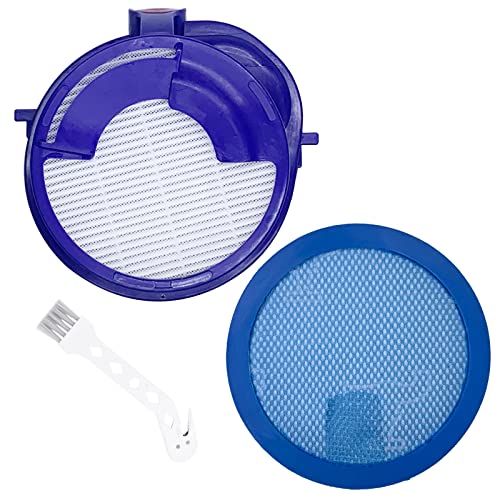
Comprehensive kit with HEPA and washable filters for DC24 models
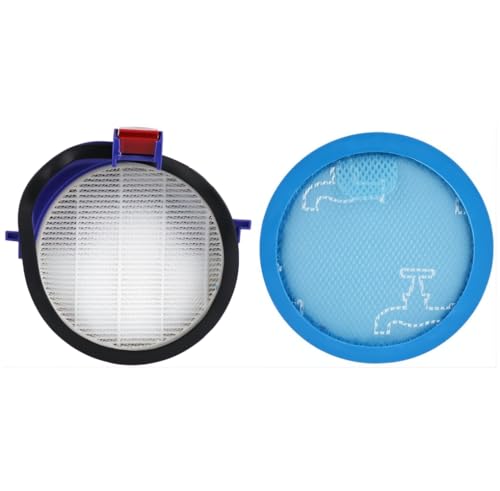
Premium HEPA kit with durable washable filters
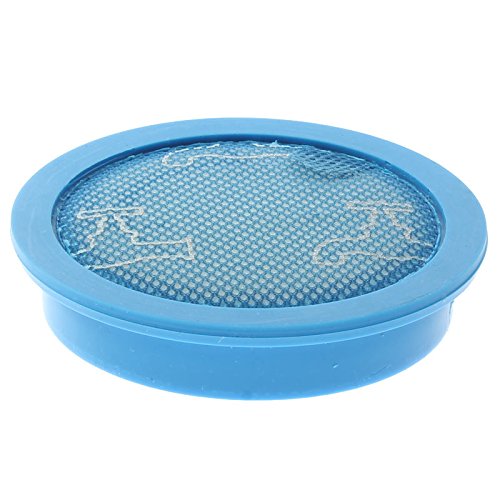
Affordable replacement for DC24 pre-motor filter
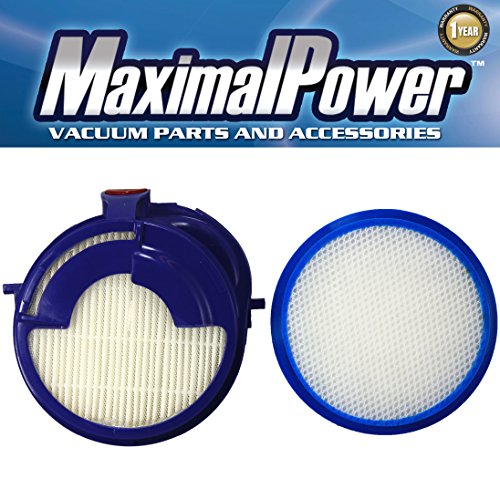
Premium dual-filter set with satisfaction warranty
Full or Improperly Sealed Dust Bin
A full dust bin or one that isn’t properly sealed can significantly reduce suction power:
- Press the bin release button to open the lid
- Hold the vacuum over a trash can and press the bin eject button
- Wipe the inside of the bin with a damp cloth to remove residual dirt
- Check the bin seals for damage or debris
- Ensure the bin clicks securely back into place when reattached
For best performance, empty the dust bin after each use, especially when dealing with fine dust or pet hair.
Blocked Hose and Airway Obstructions
Blockages in the hose or airways are common causes of sudden suction loss:
- Detach the hose from both ends of the vacuum
- Visually inspect for obvious blockages
- Use a long, thin object (like a straightened coat hanger) to gently probe for obstructions
- For stubborn blockages, run water through the hose
- Allow to dry completely before reattaching
Don’t forget to check the wand and other connecting tubes for blockages as well.
If your hose is damaged beyond repair or has persistent blockages, consider replacing it to restore optimal suction.
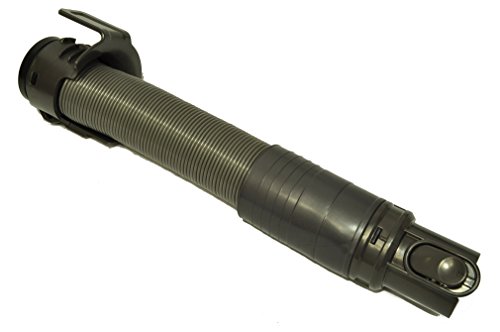
Official Dyson replacement hose with OEM compatibility

Brand-specific fit with precision engineering
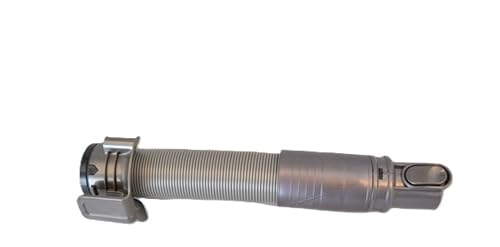
Cost-effective generic option with dual diameter

Affordable non-genuine with model-specific fit
Fixing the Changeover Valve: A Critical Suction Component
The changeover valve controls suction distribution between the cleaner head and the hose. When it malfunctions, you may experience no suction at the floor head despite the motor running normally.
Diagnosing Changeover Valve Issues
- Isolate the problem: Remove the cleaner head and test suction directly from the connection point
- Test in different positions: Recline the machine and test suction again
- Compare suction points: If there’s strong suction from the machine base but not from the hose, the changeover valve is likely the culprit
Fixing the Changeover Valve
- Locate the small tube with a red cap at the back of the machine
- Ensure the tube is properly attached and seated
- Carefully pull the tube out to inspect for blockages
- Check for any foreign objects that might be preventing the valve from moving freely
- Remove any debris or obstructions with tweezers or a similar tool
- Verify the valve moves smoothly between positions
Real user experiences: Several DC24 owners have reported finding small objects like pens, pieces of tubing, or accumulated debris causing changeover valve issues. One user found a tiny clear piece of tubing obstructing the valve, while another discovered a pen lodged in the mechanism.
Addressing Cyclone Seal Problems
A failing cyclone seal can cause significant suction loss and is often indicated by fine dust accumulating on the back spine of the machine, hose cuff, and back of the cyclone bin.
Diagnosing Cyclone Seal Issues
Look for these telltale signs:
– Fine dust appearing on the back of the machine
– Dust escaping from the cyclone assembly
– Reduced suction despite clean filters and clear airways
Repairing the Cyclone Seal
- Remove the 5 screws located under the pre-motor filter
- Carefully take apart the cyclone assembly
- Inspect the seal for gaps, deterioration, or damage
- For temporary repairs, apply electrical tape to seal any gaps
- For a more permanent solution, use clear epoxy to repair the seal
- If severely damaged, contact Dyson customer service for a replacement cyclone assembly
Maintenance tip: When reinstalling the cyclone, ensure the spring is properly positioned for correct sealing.
Troubleshooting Brush Bar Problems
The brush bar is crucial for effective carpet cleaning, and issues here can make it seem like your vacuum has lost suction power.
Cleaning and Maintaining the Brush Bar
- Turn off and unplug the vacuum
- Use scissors to carefully cut through hair or fibers wrapped around the brush
- Remove all debris and check for damage to the bristles
- If necessary, disassemble the brush bar to clean the spindle
- Ensure the brush spins freely after cleaning
- Check the brush belt for wear or damage
For persistent issues, you may need to replace the brush bar or its belt. A properly functioning brush bar should spin freely with minimal resistance. If the brush bar is worn or damaged, replacing it can improve cleaning performance. Additionally, a worn or broken brush bar belt will prevent the brush from spinning, so it’s important to replace it if necessary.
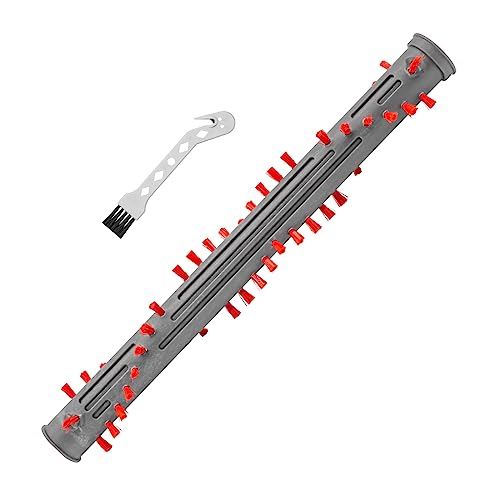
Affordable replacement with compatible part numbers and easy installation.

Durable brush bar with adjustable rotation for tangle-free hair.
Search term for Amazon: Dyson DC24 brush belt replacement
Main Motor Troubleshooting

If your vacuum’s brush bar operates but there’s no suction, the main motor might be failing.
Diagnosing Motor Issues
- Listen for unusual noises when the vacuum is running
- Check if the vacuum overheats quickly during use
- Verify if the suction is completely absent despite all other components being clear
Motor Repair or Replacement
- Disassemble the vacuum to inspect the brush bar switch and power harness
- Check for loose connections or visible damage
- For motor replacement, follow these steps:
- Remove the outer casing
- Disconnect the power harness
- Remove the mounting screws
- Install the new motor
- Reconnect all wiring
- Reassemble the vacuum
Note: Motor replacement is one of the more complex repairs and may require technical skills. Consider professional service if you’re not comfortable with electrical components.
Preventative Maintenance Schedule
Implement this maintenance schedule to prevent future suction problems:
After Each Use:
– Empty the dust bin
– Check for obvious blockages
– Remove any wrapped hair from the brush bar
Monthly:
– Clean both filters
– Inspect the hose for damage or blockages
– Check the cyclone seal for dust leakage
Every 3-6 Months:
– Deep clean the cyclone assembly
– Inspect and clean the changeover valve
– Check all seals and gaskets for wear
Frequently Asked Questions (FAQ)
Why does my Dyson DC24 have good suction from the hose but not from the floor head?
This is typically a changeover valve issue. The valve directs suction between the hose and floor head. When it’s blocked or stuck, suction may be strong from one point but weak or nonexistent from the other. Follow the changeover valve troubleshooting steps above to address this common problem.
How often should I clean the filters on my Dyson DC24?
Dyson recommends cleaning both filters monthly for optimal performance. However, if you have pets or vacuum frequently, you might need to clean them more often. Always allow filters to dry completely (at least 24 hours) before reinstalling them to prevent mold growth and motor damage.
My Dyson DC24 makes a high-pitched noise and has reduced suction. What’s wrong?
A high-pitched noise often indicates an obstruction somewhere in the airflow path. First, check for blockages in the hose, wand, and brush bar. If the noise persists, inspect the motor housing for debris that might be affecting the fan. In some cases, this could indicate bearing wear in the motor, which might require professional service.
Can I wash the cyclone assembly of my Dyson DC24?
Yes, you can clean the cyclone assembly if it’s excessively dirty. Remove it from the vacuum, rinse it in hot, soapy water with a mild disinfectant, and allow it to dry completely for at least 24 hours before reinstalling. Be careful not to damage any seals or gaskets during cleaning, as this could worsen suction problems.
Why is dust escaping from my Dyson DC24 during operation?
Dust escaping from the vacuum usually indicates a seal problem. The most common culprit is the cyclone seal, which can deteriorate over time. Inspect the cyclone assembly for gaps or damage and repair or replace as needed. Also check that the dust bin is properly seated and that all filters are correctly installed.
Conclusion
The Dyson DC24 Multi-Floor vacuum is a reliable cleaning tool when properly maintained. Most suction issues can be resolved through regular maintenance and targeted troubleshooting of specific components like filters, the dust bin, hose, changeover valve, cyclone seal, and brush bar.
By following the detailed steps in this guide, you can diagnose and fix most suction problems without professional help. Remember that preventative maintenance is the key to avoiding future issues—clean your filters regularly, empty the dust bin after each use, and periodically check for blockages in the airways.
With proper care, your Dyson DC24 can continue to provide powerful cleaning performance for many years to come, saving you the expense of premature replacement and ensuring your home stays clean and dust-free.







